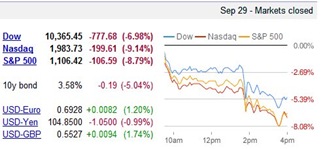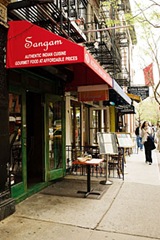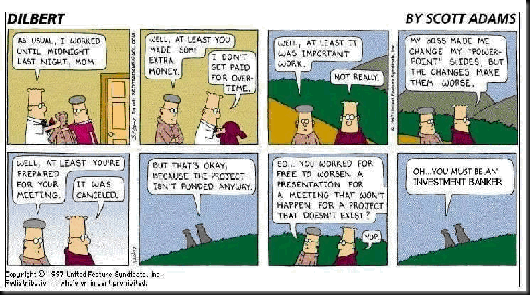Saturday, December 13, 2008
Tuesday, October 21, 2008
Untangling Credit Default Swaps
Credit Default Swaps are sort of the nuclear power of the finance world. They have the potential to be a cheap source of enormous energy but when they go bust, you get this: the financial world's version of Chernobyl:
Posted by
Kautilya
at
10/21/2008 05:26:00 PM
0
comments
![]()
Labels: Wall Street
Uncorking CDOs
Here is a second video from Marketplace that does a pretty good job of explaining the arcane world of Collateralized Debt Obligations or CDOs:
Posted by
Kautilya
at
10/21/2008 05:20:00 PM
0
comments
![]()
Labels: Wall Street
The Credit Crisis Explained
I came across these videos from Marketplace that are perhaps the clearest, simplest illustrations of the credit / financial conflagration that started on Wall Street and has now spread around the world. I never actually thought that there was any easy way to explain credit default swaps or CDOs but these guys do a pretty damn good job of it. This is the first video:
The Credit Crisis as an Atlantic Expedition
Posted by
Kautilya
at
10/21/2008 05:17:00 PM
0
comments
![]()
Labels: Wall Street
Tuesday, September 30, 2008
Party like it's 1999
Just so everyone remembers, exactly nine years ago is when this whole merry-go-around started:
FANNIE MAE EASES CREDIT TO AID MORTGAGE LENDING
In a move that could help increase home ownership rates among minorities and low-income consumers, the Fannie Mae Corporation is easing the credit requirements on loans that it will purchase from banks and other lenders.
Posted by
Kautilya
at
9/30/2008 11:01:00 PM
0
comments
![]()
Labels: New York, Wall Street
And... we're back!
Posted by
Kautilya
at
9/30/2008 10:48:00 PM
0
comments
![]()
Labels: New York, Wall Street
Monday, September 29, 2008
'Cause I'm Free... Free Fallin'
 Remember how a couple of weeks ago I mentioned that the Dow had dropped 500 points, making it the largest single day drop since 9/11? I had italicized it and everything. Well, that was... how do I put this delicately? ... a Sunday stroll in Central Park. On a spring afternoon.
Remember how a couple of weeks ago I mentioned that the Dow had dropped 500 points, making it the largest single day drop since 9/11? I had italicized it and everything. Well, that was... how do I put this delicately? ... a Sunday stroll in Central Park. On a spring afternoon.
BECAUSE TODAY THE DOW SHED 800 POINTS!
Or nearly 7%. Or about $1.2 trillion (yeah, that's with a 't' - again) in market capitalization.
Making it the largest single day drop since Black Monday - October 19, 1987 - when it dropped 23%.
That's it - I'm speechless.
Posted by
Kautilya
at
9/29/2008 11:01:00 PM
0
comments
![]()
Labels: New York, Wall Street
Wednesday, September 17, 2008
Déjà Frikkin' Vu
Another day, another bloodbath...
The Dow shed 450 points in the second largest sell-off this year. Considering that the largest occurred only two days ago, this is beginning to feel like a gang-bang! Once again it was financial stocks that got battered, in particular Morgan Stanley and Goldman Sachs, the last two independent investment banks left standing. MS dropped 28% from its Tuesday close and GS dropped 19%, leading some observers (ok, only me) to wonder - if their stocks took such a battering the day after they announced results in which they beat analysts' consensus estimates, what else is there left to say?
The fierce, and relentless, pounding has started to make dents in the MS edifice at least. It has started preliminary merger talks with Wachovia. Perhaps MS CEO John Mack wants to ahead of the game, a la Merrill Lynch, but I sure hope he knows what he's doing. Now that the market has sniffed MS blood in the water, if he has started something he cannot finish and these talks go nowhere, things could get very ugly for MS indeed.
Posted by
Kautilya
at
9/17/2008 10:52:00 PM
0
comments
![]()
Labels: New York, Wall Street
Wise Man Say... 08.04
This too shall pass.
- King Solomon
Update (9.29.08): Will it?
Posted by
Kautilya
at
9/17/2008 02:21:00 AM
0
comments
![]()
Hold the Horses?
Just as we thought that the end of the world was upon us, comes news that it might have been temporarily postponed. After doing nothing to save Lehman Brothers from bankruptcy over the weekend, the Fed finally blinked and has decided to extend a 'bridge loan' of $85 billion to AIG, which otherwise would have filed bankruptcy on Wednesday (it had apparently already engaged the same bankruptcy lawyers as Lehman to handle their paperwork. If only Weil Gotshal & Manges were a public company. Now, there's a growth stock for you!). Under the terms of the deal, in return for the lifeline, the US government will get an 80% stake in the company. The line of credit is available for two years, will accrue interest at 3M LIBOR + 850 and will be repaid by the sale of AIG's assets. The loan is collateralized by all the assets of AIG and the US government has right to veto the payment of dividends to common and preferred shareholders. This basically means that shareholders of AIG will be 'severely diluted' (read wiped-out).
It also means that AIG will eventually be liquidated, likely sooner rather than later, just not at the fire sale prices that would have been the result of a bankruptcy. Considering that AIG has over $1 trillion in assets (again, with the 't'!), a bankruptcy slash fire sale would have made the Lehman situation look like a Thanksgiving sale at Macy's. Plus, with the agencies downgrading AIG by two (Moody's, Fitch) to three notches (S&P), it would be required to post an additional $13.3 billion of collateral, money it simply did not have.
In sum, AIG "could not be allowed to fail."
In other news, Barclays PLC has agreed to buy the US investment bank of Lehman Brothers for $2 billion and about 9,000 employees of the investment bank will join Barclays. Not included in the sale are any of "Lehman’s real estate, real-estate-backed securities, derivatives positions or over-the-counter trades." So, Barclays is basically buying the 'good' parts of Lehman and is getting almost exactly the same deal it wanted when it was negotiating a sale of Lehman over the weekend but Dick Fuld had put the kibosh on those plans.
But because Lehman, the holding company, is under bankruptcy protection, Barclays can pick and choose the parts of the company it wants and leave the rest to be liquidated by the bankruptcy court. So Lehman's filing bankruptcy got Barclays the deal Lehman wouldn't do to save itself.
Oh, the irony.
Posted by
Kautilya
at
9/17/2008 02:12:00 AM
0
comments
![]()
Labels: New York, Wall Street
R.I.P - Richard Wright
Richard Wright, one of the founding members of Pink Floyd along with Roger Waters, Nick Mason and Syd Barrett has gone to the Dark Side of the Moon.
And I am not frightened of dying, any time will do, I
Dont mind. why should I be frightened of dying?
Theres no reason for it, youve gotta go sometime.- Richard Wright, The Great Gig in the Sky
Posted by
Kautilya
at
9/17/2008 01:03:00 AM
0
comments
![]()
Labels: Music
R.I.P - David Foster Wallace
 David Foster Wallace - novelist, philosopher, journalist, humorist and one of the best wordsmiths to put pen to paper died on September 12, apparently having committed suicide by hanging himself.
David Foster Wallace - novelist, philosopher, journalist, humorist and one of the best wordsmiths to put pen to paper died on September 12, apparently having committed suicide by hanging himself.
In his fiction, Wallace was considered the heir of Thomas Pynchon and Don DeLillo and in his essays and observational pieces, he could be a combination of Malcolm Gladwell and Chuck Klosterman. He could write with equal felicity about tennis, porn or food. He was published in the New York Times Magazine, the New Yorker and in Playboy. His breakthrough novel, Infinite Jest was named one of Time magazine's 100 Best English Language Novels.
I first learnt of Wallace from a 2004 Gourmet magazine article about the ethical complexities of boiling alive lobsters for food. I remember thinking at the time, 'this is an odd article for a food magazine.' But that was the subversive genius of Wallace - he could write a philosophical screed on the "whole animal cruelty and eating issue" in a food magazine. I'm sure that when Gourmet commissioned him to write the article, they were expecting a standard issue travelogue , not a footnoted, annotated essay, which as Slate writer Troy Patterson puts it, "ranks as a must-read for anyone even thinking of having dinner."
Since we all think of having dinner at some point, here is the article. Hopefully, it will make us think also of David Foster Wallace.
Godspeed, and farewell.
Posted by
Kautilya
at
9/17/2008 12:40:00 AM
0
comments
![]()
Monday, September 15, 2008
Behold a Pale Horse
Wow! What else can you say but, Wow! I thought that the Thursday-Sunday stretch this summer that  gobbled up Bear Stearns was breathtaking, I thought the disappearance of Fannie Mae and Freddie Mac were once in a lifetime events but this... this is a whole new order of magnitude.
gobbled up Bear Stearns was breathtaking, I thought the disappearance of Fannie Mae and Freddie Mac were once in a lifetime events but this... this is a whole new order of magnitude.
Two of the world's largest investment banks ceased to exist this weekend. And they weren't the 95-pound weaklings that Bear was either. They were behemoths. Lehman Brothers had 26,000 employees worldwide. Merrill Lynch had over 60,000. Between them they probably managed over a trillion dollars worth of assets (yes, that's trillion with a 't').
Unlike the Fed, which did not see fit to save the 3rd and 4th largest investment banks in the world, the markets decided that that the failures of Lehman and Merrill were sufficiently cataclysmic events to shed 505 points - the largest single-day drop in the Dow Jones index since September 17, 2001, the day the markets re-opened after 9/11.
Merrill, of course made out much better than Lehman and it's pre-emptive sale to Bank of America for $50 billion (or about $30/ share) is a huge premium to where it's stock closed today ($17.06/ share). And then there is Merrill's crown jewel, it's fabled "Thundering Herd" of brokers, 17,000 strong, who will likely get absorbed into B of A. But that still leaves another 40-45,000 Merrill employees, a lot of whom (some say as much - or, at least! - half) could end up getting laid off. Not to mention the thousands of B of A employees who will get laid off through no fault of theirs - because they were actually good at their jobs.
And as for Lehman? Well, Lehman doesn't have an All-Blacks of a brokerage team to offer, only $40 billion is toxic real estate debt, and so for the 26,000 Lehman employees, this is the end of the road.
As bad as things got today, they have the potential to get much worse. AIG, the largest insurer in the world as little as a year ago, is on the verge of collapse, an event that would be an even bigger shock to the system (if such a thing is even possible anymore), if for nothing else than the fact that it is part of the Dow Jones index. Its stock price closed at less than $5/ share today, down from $65/ share a year ago, and rumors are that the Fed has asked Goldman Sachs and JPMorgan Chase to lend $70 billion(!) to the insurer. Even if GS and JPM had that kind of money laying around, which they don't; or even if they could syndicate this debt, which they likely can't - is it really going to help at this stage? Or is this like sticking a finger in the dyke and hoping that the dam holds?
Then there is Washington Mutual, whose stock is trading at less than $3.32/ share and whom S&P and Moody's downgraded to junk status. WaMu looks like it is ripe for failure as well and oh, by the way - it only has $180 billion of exposure to mortgages and related loans.
And finally, consider this: The brokerage subsidiaries of Lehman Brothers were not included in the bankruptcy filings today and remain open for business for the time being. So, the liquidation of Lehman hasn't even started and the already the markets are down 500 points.
So, if you see four horsemen riding about, be afraid. Be very afraid.
Posted by
Kautilya
at
9/15/2008 11:18:00 PM
2
comments
![]()
Labels: New York, Wall Street, Work
Wednesday, August 20, 2008
Wise Man Say... 08.03
There are 10 kinds of people in the world. Those who understand binary and those who don't.
- Anon
Posted by
Kautilya
at
8/20/2008 09:01:00 PM
0
comments
![]()
Labels: Random Thoughts
Sunday, August 03, 2008
Sunday, June 01, 2008
The Best Biryani in New York
 Omigod! I think I may just have eaten the best biryani there is in New York City! Sangam is that proverbial hole-in-the-wall restaurant (it only seats six) that serves fantastic food from a limited menu. For most such places, the hype usually overshadows the food, but for Sangam, believe the hype, man (or at least get there fast, before the hype does overshadow the food).
Omigod! I think I may just have eaten the best biryani there is in New York City! Sangam is that proverbial hole-in-the-wall restaurant (it only seats six) that serves fantastic food from a limited menu. For most such places, the hype usually overshadows the food, but for Sangam, believe the hype, man (or at least get there fast, before the hype does overshadow the food).
As for the hype, here's what you need to know. I actually found and ate every last grain of rice of the biryani that we got on our last visit, literally - including a few that had fallen off my plate and on the table (much to the disgust of my date). I gnawed at the lamb bones. I even ate the frikkin' raita! I thought of my Mom.
In addition to the biryani (of which there are lamb, chicken and vegetarian variants), Sangam makes a Nargisi roll to die for. My only grouch is that they use ground chicken instead of lamb or beef. And for dessert, there is phirni, which, no exaggeration, will take you back to Birhana Road in Kanpur.
They have some vegetarian dooh-dahs - samosas, veggie rolls and the like - which are probably quite good too (I have no idea, 'cause I didn't try them - see no reason to).
Here's the kicker - Two people can eat there for under 30 bucks! The biryanis go for $7 - $9 depending on what you get, the rolls are $8 for a pair and the phirni is $3. And... on weekends they're open till 2 in the morning!
Someone please wake me - this has got to be a dream.
Apparently Ishrat Ansari, one of the co-owners started the restaurant because his wife made the biryani for some friends, word spread and soon they were deluged with requests for more. I say, good call Ishrat.
Sangam, 190 Bleecker St., New York, NY 10012. Ph: 212.228.4648. Open 1PM - 11PM M-T; 1PM - 2AM F-S.
Posted by
Kautilya
at
6/01/2008 02:43:00 AM
0
comments
![]()
Wednesday, May 28, 2008
READY! AIM! ........... fire
Given the financial turmoil that Wall Street and most of it's players are in, massive layoffs amongst the heavy hitters of the financial world was to be expected. Everyone on the Street knew that they were coming and in their own way, perhaps even prepared for it. However, the layoffs in this cycle have been different than in those of crises past.
In 1987 after the stock market crash, in 1998 in the aftermath of the LTCM and Russian default crisis and in 2001 after the bursting of the dot com bubble and 9/11, there was a huge amount of bloodletting on the streets of Downtown New York. But it was done en masse, publicly and in one fell swoop. Merill Lynch laid off close to 20,000 employees in 2001, over 10,000 in the fourth quarter alone, undone by the double whammy of the bursting of the tech bubble and Sept. 11.
However, the layoffs in this cycle are markedly different. They are almost being done on the down low, the corporate equivalent of the 3 AM knock on the door. The New York Times in an article called them 'stealth layoffs' and that 'the first clue that someone is gone can be e-mail messages that are returned to senders from a former colleague’s inactivated corporate address.' People who have worked at their companies for a decade or more have been, and are being, shown the door. And in the face of all the 'different opportunities being pursued' and 'different directions being gone in' and the amount of 'time being spent with the family' all around us, almost no public acknowledgement is been made of the people leaving.
Although Wall Street has announced the elimination of about 65,000 jobs in 2008, this time the layoffs have been spread out over weeks and months. As a result of this death by a thousand cuts system of layoffs there is an atmosphere of 'fear, paranoia and anger' amongst employees as they wonder who will be next or when the bells will toll for them. The constant and ever present of losing their jobs, of not knowing in the morning if they will be unemployed by the evening and most of all, not knowing when it will stop is taking its own heavy toll. One banker interviewed by the New York Times pretty much hit the nail on the head when he said that before the layoffs there was a sense of loyalty with the bank, a sense of pride, "that they got my back." But he said that that idea of loyalty had gone from most banks.
Most Wall Street financial institutions have extensive orientation programs for new employees and one of the things stressed is how the institution takes care of its own, even talking about its 'alumni networks' and the excellent business relations it has with its former employees. When new people join the firm, they introduced with great pomp and pride at the weekly meetings but when they leave (voluntarily or otherwise), absolutely no mention is made of it. It's as if the person never even existed.
Call me naive but the realization that an organization could be so mercenary in kicking to the curb employees it felt that it didn't need anymore was kind of shocking. And how is it that most of the financial institutions on Wall Street are behaving the same way in how they deal with layoffs? Like some sort of fashion fad, everyone seems to have gotten the same idea at the same time. I wonder how that works - do CEOs of major investment banks get together and develop a common firing strategy for the year? Bizarre.
And sad.
Posted by
Kautilya
at
5/28/2008 01:26:00 AM
0
comments
![]()
Labels: Navel Gazed, New York, Wall Street, Work
Thursday, May 22, 2008
Still Standing... barely.
And then, the bottom fell out. A combination of banks and financial institutions making loans to people who didn't even come close to qualifying for them; selling loans that were little more than lipstick on pigs and selling securities that promised to turn base metal to gold has led the Street to the brink of the greatest financial disaster since the Great Depression.
About a year later, nearly 20,000 people have lost their jobs on Wall Street alone, with no signs of the bleeding stopping anytime soon; the venerable Bear Stearns has ceased to exist, foundering from it's perch on the Fortune 500 in less than a week; and fear and paranoia stalks those of us still standing. Going to work every morning not knowing if one will have a job at the end of the day makes for a whole new definition of stress.
A few years from now, if not already, histories will be written about the 'Great Credit Crunch of 2007' and learned scholars will try to explain what happened, why and who did what to whom. It will all be very well researched and footnoted and annotated and will become part of business school syllabi. But, as Rose Bukater says of surviving the shipwreck at the beginning of Titanic, "the [actual] experience of it [is] somewhat less clinical."
An experience I would never want to relive.
Posted by
Kautilya
at
5/22/2008 10:34:00 PM
2
comments
![]()
Labels: Navel Gazed, Wall Street, Work
Wednesday, May 21, 2008
Wise Man Say... 08.01
"There are roughly three New Yorks. There is, first, the New York of the man or woman who was born there, who takes the city for granted and accepts its size, its turbulence as natural and inevitable. Second, there is the New York of the commuter--the city that is devoured by locusts each day and spat out each night.
Third, there is New York of the person who was born somewhere else and came to New York in quest of something... Commuters give the city its tidal restlessness, natives give it solidity and continuity, but the settlers give it passion."
E.B. White, 'Here is New York'*
*White, E.B. (1949), 'Here is New York', Harper & Brothers, New York, NY, pp 53-54. Reprinted: 2000, Little Bookworm, New York, NY
Posted by
Kautilya
at
5/21/2008 10:55:00 AM
0
comments
![]()
Labels: New York
Fire!
In the closed confines of the bookstore, the shrieking of the alarm was even louder than usual - deafening, for once, was not an exggeration. A few minutes later the fire trucks arrived, sirens wailing, to add to the cacophony. In trooped five of New York's brvaest, in full combat gear. The owner/ manager/ person in-charge of the shop told them it was a false alarm, they checked that everything was alright, switched off the alarm and went back.
No one left the building, no one panicked, no one stopped talking except to assert, with the absolute certainty that only New Yorkers have, that it was a false alarm, heck - no one even stopped browsing! The sales clerks continued to ring up sales and other than the approx. 6,000 db sound level inside the store and men in red hats and axes standing around the entrance, it was as if it was business as usual. Come to think of it, it was business as usual. Through all the brouhaha, the people in the bookstore reacted - by not reacting at all!
Only in New York, folks, only in New York!
Posted by
Kautilya
at
5/21/2008 10:36:00 AM
3
comments
![]()














